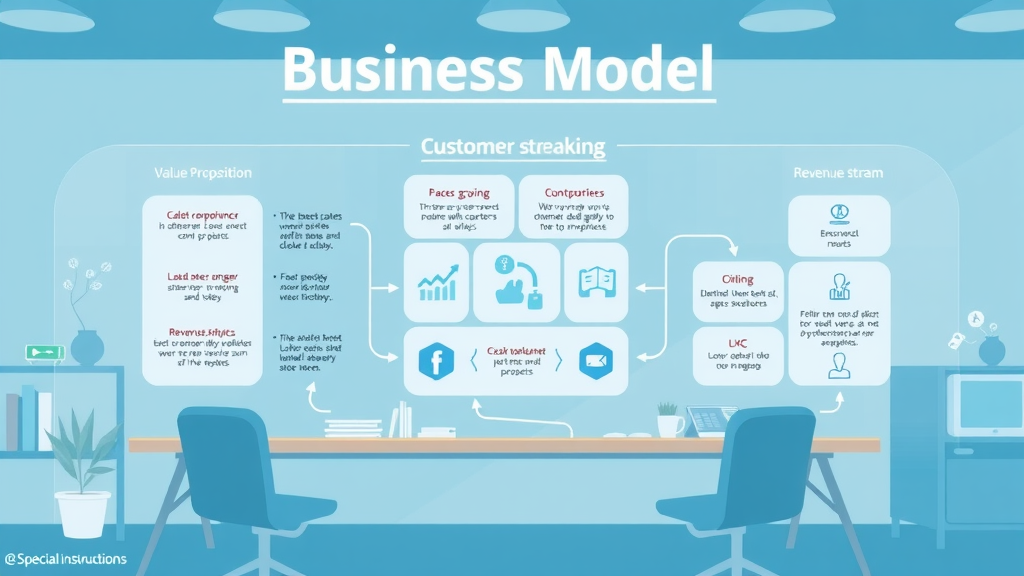Did you know that over 90% of online businesses fail due to choosing the wrong business model ? In today's digital world, selecting the right online marketing business models can be the difference between mediocrity and a thriving, successful business. This comprehensive guide uncovers unconventional facts, actionable strategies, and proven paths that help you make money and build a sustainable ecommerce business in 2024 and beyond.
How Online Marketing Business Models Are Shaping Today’s Successful Business Landscape
The evolution of online marketing business models is fundamentally reshaping how successful businesses operate in the digital era. Unlike traditional business models that rely on physical presence and brick-and-mortar stores, today’s most innovative online business ventures leverage creative digital strategies, diverse revenue streams, and advanced technology to reach worldwide audiences quickly. The accessibility of ecommerce business platforms means entrepreneurs can test, scale, and pivot more efficiently than ever, directly impacting how products and services are delivered to buyers and sellers.
Consider how social media, affiliate marketing, and digital product sales have fueled growth for countless new ventures. Modern business models reduce overhead, streamline the supply chain, and allow for rapid experimentation—creating more models to choose from for every type of business. Whether you’re building an online store or launching a subscription business model, the opportunities for direct engagement and personalized value propositions accelerate business growth.

Leveraging Unconventional Facts in Online Marketing Business Models
Many assume online business success is about being first or luck. The reality? The underlying business model you choose dictates your chance of sustainable, profitable growth. As noted in a recent study:
"According to a recent study, over 90% of online businesses fail due to the wrong selection of business models, highlighting the critical role of strategy in ecommerce success."
This makes your choice of business model, from freemium models to hourly rate consultations, a pivotal factor. Innovators in digital services frequently outperform competitors by applying fresh thinking—such as blending affiliate marketing with subscription models or leveraging hybrid digital product and ecommerce business models. These unconventional habits are now required to truly thrive online.
Comprehensive Guide: Key Components of Online Marketing Business Models
To develop a winning strategy for your online business, you must master the five foundational components of effective online marketing business models :
- Value Proposition
- Revenue Model
- Customer Segmentation
- Sales Process
- Fulfillment and Delivery Channels
Value proposition clarifies why your products or services matter to your audience, while the revenue model defines how you generate revenue —be it through direct sales, subscriptions, or affiliate commissions. By analyzing customer segmentation, you tailor your approach for maximum reach and conversion, ensuring your sales process is both efficient and engaging. Finally, selecting the right fulfillment and delivery channels ensures you can meet and exceed customer expectations, whether providing a physical product, digital download, or online service.

What You’ll Gain from Mastering Online Marketing Business Models
Understanding and applying the fundamentals of online marketing business models unlocks several competitive advantages. Here’s what mastering this landscape offers:
- Strategic insight for online business expansion
- Practical methods to implement successful business models
- Understanding of ecommerce business potential
- Tools to adapt your business plan for digital growth
By gaining these competencies, you’re equipped to evaluate which type of business model aligns with your strengths and resources. This enables you to advance beyond trial-and-error tactics, building an online business that scales and endures through shifting market trends. Whether your goal is rapid growth, long-term sustainability, or maximizing your ability to make money online, this knowledge is invaluable.
Exploring the Core Types of Online Marketing Business Models
There are several core business models in the digital marketing space, each providing unique pathways to reach your target audience, generate revenue , and grow your online business . By exploring the strengths and weaknesses of each, you can determine which best supports your goals, whether selling a digital product, managing an ecommerce business, or launching a subscription model .
Traditional Business Model vs. Digital Product Models
The traditional business model often centers on physical product sales in brick-and-mortar stores, regional distribution, and direct supplier relationships. In contrast, the digital product model leverages the power of internet delivery—offering everything from ebooks and SaaS to digital services that don’t require physical inventory or complex supply chains.
Digital product business models often provide seamless scalability and lower upfront investment, allowing you to diversify your customer base and reach a global audience instantly. Both options have their merits—but which is right for your online business ? Let’s compare both sides:
| Feature | Traditional Model | Digital Product Model |
|---|---|---|
| Product Type | Physical goods | eBooks, SaaS, online courses |
| Sales Channel | In-store/physical retail | Online portal/digital marketplace |
| Pros | Tangible product, local trust | Scalable, low inventory cost, 24/7 sales |
| Cons | High overhead, limited reach | High competition, digital piracy |
| Revenue Streams | One-time sales | Licensing, subscriptions, upgrades |

Understanding the Subscription Model and Subscription Business Growth
A subscription model delivers continuous value to customers in exchange for recurring payments. Popular among SaaS providers and media companies, subscription business models create stable, predictable income and enable deeper customer relationships over time.
- Continuous revenue generation
- Customer retention strategies
- Examples in software and services
Many successful businesses rely on subscription models to boost customer lifetime value and foster loyalty—think Spotify, Netflix, and Adobe Creative Cloud. By delivering value consistently and building in smart upsell paths (like freemium business options or digital product add-ons), you can maximize profit while minimizing churn.
How the Freemium Business Model Drives User Acquisition
The freemium business model offers a basic version of a digital product for free, inviting widespread user adoption. Revenue is generated through premium feature upgrades, with the model relying on a percentage of users converting to paid plans. This approach is prevalent in apps, SaaS, and digital services.
By building a large initial customer base and giving users a taste of the product or service’s value, businesses can then nurture customers toward premium tiers. Social media tools, productivity platforms, and online learning apps often use this model to explode user growth and increase their reach.

Analyzing the Affiliate Marketing Model in Online Business
Affiliate marketing enables performance-based earning by rewarding partners (affiliates) who promote your goods and services to new audiences. Through data-driven campaigns and optimized affiliate networks, you can drive incremental growth without upfront expenses.
- Performance-based earnings
- Network expansion
- Scalability factors
This business model is especially popular among content creators and bloggers who want to make money by connecting their audience with relevant products or services. Success depends on transparency, accuracy in referral tracking, and ongoing optimization of the affiliate program itself.
Advertising-Based Business Models Explained
The advertising-based model uses digital platforms (like blogs, media sites, or apps) to monetize user attention, often through:
- Cost-per-click (CPC)
- Cost-per-impression (CPM)
- Sponsorship deals
By aggregating a large, engaged audience, businesses can partner with advertisers or sponsors to generate revenue without selling their own products or services directly. Digital publishers, streaming sites, and online communities frequently leverage this approach to scale profitably.
Advanced Ecommerce Business Model Examples That Work
Ecommerce opens an expansive world of business models to choose from, letting you tailor your strategy to market demand, available resources, and your desired speed of scaling. Whether you’re experimenting with dropshipping, launching a print-on-demand online store, or creating an online marketplace, each model offers unique operational and financial advantages.
Dropshipping, Print-on-Demand, and Online Marketplaces
Dropshipping is a popular ecommerce business model that doesn’t require you to keep inventory. Instead, when a customer makes a purchase, the item is shipped from a third-party supplier directly to them. This reduces the risks and costs traditionally associated with the supply chain.
Print-on-demand lets you sell custom apparel, accessories, or artwork—produced only after a customer places an order. Meanwhile, online marketplaces like Etsy or Amazon connect buyers and sellers across diverse product categories, streamlining the process of discovery and sales.
| Model | Inventory | Risk Level | Customization | Revenue Streams |
|---|---|---|---|---|
| Dropshipping | None | Low | Low | Product sales |
| Print-on-Demand | Produced per order | Low | High | Product sales, design fees |
| Marketplace | Varies | Varies | Medium | Commission, listing fees |

Developing a Comprehensive Business Plan for Online Marketing Success
- Objectives
- Market Analysis
- Execution Strategy
- Projected Revenue Streams
A data-driven business plan helps you map the path from concept to scalable online business. Set clear objectives, perform thorough market analysis, and outline a step-by-step execution strategy—considering both short-term wins and long-term sustainability. Identify distinct revenue streams and leverage tools that support ongoing market adaptation and optimization.
For example, a typical ecommerce business plan may analyze societal trends (such as the rise of social media shopping), plan out digital product launches, and test different supply chain partners. Your plan should account for evolving customer needs and model potential risks to ensure lasting success.
Real-World Case Studies: Achieving a Successful Business Online
Learning from real-world examples can fast-track your journey toward building a successful business with online marketing business models.
Case Study: Scaling a SaaS Platform with Subscription Model
A SaaS startup initially struggled with one-off license sales and an inconsistent customer base. After switching to a recurring subscription model , the company introduced tiered pricing, value-added digital product features, and automated retention campaigns.
"Implementing a subscription business model enabled us to increase our customer lifetime value by over 300% within two years." – SaaS Founder
This shift created sustainable growth and provided the financial stability needed to invest in further product and service enhancements.
Case Study: Affiliate Marketing Triumph in the E-Learning Sector
An online education platform grew its reach by tapping into affiliate marketing . By creating a network of content creators and leveraging social media strategies, the company rapidly expanded its user base and reward-based revenue.
The result was a scalable model where both affiliates and the business benefited, while analytics tools provided transparent performance metrics for ongoing optimization.

Case Study: Crafting a Profitable Digital Product Offering
A solopreneur designed a niche digital product—a course for creative professionals. Through careful customer segmentation and market validation, the product launch generated significant buzz on social media. Early adopters provided feedback for optimization, which improved conversion rates and expanded the customer base.
This digital product success story highlights how nimble business models can drive real profit and allow creators to make money online quickly with limited investment.
Strategizing Revenue Streams: Blending Multiple Online Marketing Business Models
- Integrating subscription models with affiliate revenue
- Creating hybrid ecommerce business models
- Leveraging digital product add-ons
Blending different business models is a proven path for scaling and diversifying your ecommerce business. For instance, you might combine a freemium business model with premium digital product upgrades, or integrate affiliate marketing into a content-driven subscription platform. These hybrid strategies enable you to maximize revenue from multiple sources while protecting against market volatility.
Businesses embracing these blended models can offer more value, attract diverse customer segments, and adapt quickly to changes in demand or technology.
Combining Freemium and Advertising Models
Many SaaS and media companies combine the freemium business model—where most users enjoy free access—with advertising revenue streams. Free users view ads or sponsorships, subsidizing the cost of the platform while encouraging premium upgrades for an ad-free or feature-rich experience.
This approach unlocks multiple revenue sources: upgrade sales , ad revenue , and sponsor partnerships—all contributing to a more resilient business model in competitive spaces.
Maximizing Profits with Hourly Rate Consultations Embedded in Online Business
Increasingly, digital product creators and service providers are packaging hourly rate consultations alongside automated offerings. This model involves selling a product or service, then upselling one-on-one consultations, project guidance, or coaching sessions by the hour.
By embedding expert access within your online store or digital product funnel, you efficiently combine passive income potential with a premium, hands-on experience—creating powerful differentiation and new ways to generate revenue online.
Crafting a Sustainable Business Plan for Online Business Longevity
- Blueprint for rapid launch
- Building for scalability
- Long-term sustainability plans
Your business plan should lay the foundation for fast, resource-efficient entry into your market, while also considering how to scale and endure beyond early wins. Identify scalable infrastructure, automation tools, and strategic partnerships to future-proof your online business .

Set measurable goals for growth, regularly revisit your strategy in light of new trends, and invest in customer relationships to ensure your business can thrive even as competition and technology evolve.
Adapting Your Online Marketing Business Model Amidst Market Changes
No online marketing business model is static. The ability to adapt—by evaluating customer feedback, leveraging technology, and pivoting as needed—sets long-term winners apart.
Analyzing Customer Feedback for Continuous Model Optimization
Ongoing analysis of customer feedback helps refine your value proposition, highlight new opportunities, and catch early warning signs of shifting preferences. Incorporate surveys, user reviews, and social media listening into your operations to keep your business model fresh and relevant.
Businesses that succeed in the digital economy are those who treat adaptation as a habit, not just a response to crisis.
Pivoting Business Models in Response to Industry Trends
- Adapting to new platforms
- Leveraging emerging technologies
Shifts in e-commerce platforms, regulatory changes, and industry-disrupting technologies all require readiness to pivot—whether that means expanding into mobile marketplaces, using AI-driven business intelligence, or reprioritizing subscription over one-time sales.
Staying attuned to these changes allows you to adjust quickly, unlocking new opportunities for products or services that meet market demand.
Identifying Signs: When to Evolve Your Online Marketing Business Models
Watch for drops in engagement, stagnant growth, emerging competitor threats, or new customer requirements. These signs indicate it’s time to evolve your business model —perhaps by adding freemium business options, expanding your product line, or integrating new supply chain partners.

Proactive evolution is essential for maintaining a competitive edge in the fast-paced online business environment.
Essential Tools & Platforms for Managing Online Marketing Business Models
- CRM software
- Ecommerce business platforms
- Affiliate marketing networks
- Digital product marketplaces
Using the right mix of software and platforms helps you execute your business model efficiently, track performance, and scale operations. Top tools support everything from online store management to automated email marketing, payment processing, and affiliate relationship tracking.

Select solutions that integrate smoothly and support your key objectives—from boosting customer satisfaction to streamlining your supply chain or maximizing social media reach.
People Also Ask: Exploring Online Marketing Business Models
What are the 4 types of e business models?
The four types of e-business models commonly recognized are: B2C (Business to Consumer) , B2B (Business to Business) , C2C (Consumer to Consumer) , and C2B (Consumer to Business) . Each type refers to the direction of the transaction and the relationship between parties, with B2C and B2B dominating ecommerce business strategies today. Examples include online stores selling direct to consumers (B2C) or digital marketplaces enabling peer-to-peer sales (C2C).
What are the 4 types of business model?
Broadly, the four types of business models are: Product-based (selling goods), Service-based (offering expertise/solutions), Subscription-based (recurring revenue from users), and Advertising-based (generating revenue from third-party advertisers). Choosing the right type of business model affects your path to profitability and your ability to scale your online business effectively.
What are the 7 types of business models?
The seven types of business models often referenced in digital marketing include: Manufacturer , Distributor , Retailer , Franchise , Ecommerce , Freemium , and Subscription . You’ll find these models blended and adapted within most successful businesses online, as each model aligns differently with customer bases, product or service types, and digital marketing methods.
What is an online business model?
An online business model refers to the strategy a company uses to conduct commercial activities and generate revenue via the internet. This can include selling goods and services directly to consumers, providing access to digital product platforms, leveraging affiliate marketing, or earning through advertising. The key is to align your chosen model with your unique value proposition and target audience.

Visualizing Your Path: Video Guide to Online Marketing Business Models
Sometimes a visual walkthrough paints the clearest picture. Explore our in-depth video guide, unpacking real-world examples, decision-making frameworks, and tactical tips for choosing the best online marketing business models for your unique goals. This guide covers case studies, platform walkthroughs, and do’s and don’ts for every type of business model discussed above.
Leverage interactive video tools to simulate your business scenario, test different strategies, and see immediate feedback on model viability. These resources provide hands-on guidance as you decide among digital product offerings, ecommerce business types, or hybrid revenue streams tailored for your strengths.
Common Questions For Online Marketing Business Models
-
How do I choose the right business model for my digital product?
Identify your target audience’s needs, review your competitors, and evaluate platforms for delivery and monetization. Factor in your resources, preferred engagement style, and growth goals to select the model that best fits your digital product and business objectives. -
Are there risks to combining multiple online business models?
Yes, blending models without a coherent strategy can dilute your brand and confuse customers. Carefully map each revenue stream’s purpose and test new combinations incrementally to ensure operational efficiency and audience clarity. -
Which business model is best for ecommerce startups?
For ecommerce startups, dropshipping and print-on-demand offer the lowest barriers to entry, while own-inventory models can build higher margins. Consider hybrid business models for flexibility as you scale. -
How does a freemium business model attract paying customers?
It provides a risk-free entry point, demonstrating the core value of your digital product or service. Strategic feature limitations and targeted marketing turn satisfied free users into loyal, paying customers. -
Can subscription business models be profitable for small online businesses?
Absolutely—subscription business models enable recurring revenue, stabilize cash flow, and foster deeper customer loyalty, even for small teams focused on niche segments.
Advice from the Experts: Building an Effective Online Business Model
"The best online marketing business models are those built on data, adaptability, and continuous experimentation." – Digital Strategy Consultant
Data-driven decision-making and frequent testing help you keep your business plan and model tightly aligned with market needs. Never settle—refine, adapt, and seize emerging opportunities to maintain your advantage in the online business world.
Summary Table: Online Marketing Business Models at a Glance
| Model | Best For | Revenue Streams | Scalability |
|---|---|---|---|
| Ecommerce | Physical/Digital products | Sales | High |
| Subscription | SaaS, Media | Recurring | High |
| Affiliate | Content creators | Commission | Moderate |
| Freemium | Apps/SaaS | Upgrade sales | Moderate |
| Advertising | Media Sites | Ad Revenue | Variable |
Key Insights for Thriving With Online Marketing Business Models
- Select a business model aligned with your strengths and audience
- Continuously evaluate and refine your business plan
- Diversify revenue streams where feasible
- Monitor trends in ecommerce and digital product spaces
- Stay agile for ongoing market shifts
The path to a successful business online is iterative. By blending innovation, data-driven decision-making, and relentless customer focus, you’ll stand out amid the crowded digital landscape.
Take the Next Step: Implementing Online Marketing Business Models for Measurable Success
Ready to take action? Apply the strategies, tools, and insights in this guide to map your own profitable journey. Test, refine, and scale—and watch your online business become a story of lasting success.
Selecting the appropriate online marketing business model is crucial for achieving sustainable success in the digital marketplace. To deepen your understanding and explore various models, consider the following resources:
-
“10 Online Business Models to Consider” : This article provides an overview of diverse online business models, including freelancing, e-commerce, affiliate marketing, and more, helping you identify which aligns best with your skills and goals. ( themuse.com )
-
“12 Online Business Models To Consider for Growth” : This resource outlines various online business models, such as affiliate marketing and Software as a Service (SaaS), offering insights into their implementation and potential benefits. ( indeed.com )
Exploring these resources will equip you with the knowledge to choose and implement the most effective online marketing business model for your venture.
 Add Row
Add Row  Add
Add 




Write A Comment